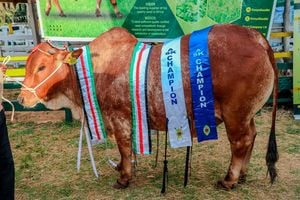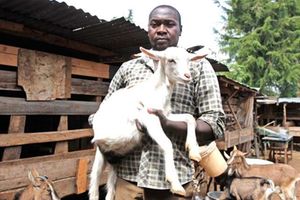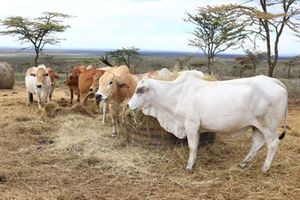
Stella Chepkemoi feeds her dairy goats at Konoin village in Kiptagich, Kuresoi South in Nakuru County.
Goat farming is increasingly gaining popularity as land parcel sizes diminish, especially in the high rainfall regions of Kenya.
Small land sizes cannot support dairy or beef cattle. This makes the goat a better option. Just like cattle farming, goat keeping requires proper and careful selection of breeds for one to realise good yields.
This article is motivated by questions from farmers and potential farmers on the most recommended breeds of dairy goats one can rear.
Many farmers keep one or two dairy cows or a few goats, mainly for milk for home consumption and manure.
It is good to note that with good management of milk, manure and the offsprings of the animals kept, one may have a higher multiplier effect on income by growing own food, producing high value foods for sale such as fruits or vegetables and selling off excess animal stock.
I always advise small-scale livestock farmers to leverage on the manure they get from their animals to produce fruits, vegetables and fodder.
This saves them the money they would have used to buy manure and food.
Fruits like avocado, loquat, passion and banana, coupled with vegetables like cabbage, spinach and sukuma wiki can be grown by small scale farmers using manure from their animals.
This would provide savings on family food costs and earn some reasonable amount of money when the excess produce is sold.
Many farmers, unfortunately, leave the manure to go to waste, resorting to using commercial fertiliser. Manure is much better and cheaper than the fertiliser and lasts long in the soil.
Those who wish to keep goats for milk should consider the breed, its productivity, availability in the country and adaptability to local conditions.
There are four main dairy goat breeds suitable for Kenya. Fortunately, the breeds are readily available.
They are available as crosses or mixes in many cases. All emanated from Europe but are now well adapted to local conditions.
The first is the Anglo-Nubian goat. It is large with a Roman or hooked nose and pendulous ears hanging low and close to the head.
Anglo-Nubians are most often black, red or tan. Mixtures of the breed with the small East African goat are abundant among farmers.
The goat was developed in England during the 19th century by crossing native stock with goats from India and North Africa.
Anglo-Nubian goats are multi-purpose – bred for milk, meat, and hides. They produce a moderate amount of milk daily. Their milk is good for cheese due to a high butterfat content.
Anglo-Nubian is the best suited dairy goat breed for hot conditions. It is commonly used for upgrading local goats for milk and meat production.
The second breed is the Toggenburg. There are two breeds. The smaller one originated from Switzerland and the other from Britain.
The British breed female weighs up to 70 kilos and buck up to 100 kilogrammes.
The Swiss type female weighs around 50kgs and the buck up to 70kgs. They are brown or greyish brown with distinctive white stripes on the face and legs. They may be horned or polled.
Males have long horns that curve backwards. They may have toggles or tassels. These are the two skin teat-like structures seen hanging on the lower jaw of a goat. They are not known to have any purpose.
Toggenburgs have a very gentle and quiet temperament. They have a long body and remain bony. Their average milk yield is one to three litres per day, depending on management.
The breed is suited for the higher cooler regions as it is affected by heat. It produces milk persistently over long periods, with the milk having a butter fat of three to four per cent.
Alpine is the third breed suitable and available in Kenya. It was developed in Britain by crossing local goats with Alpine goats imported from Switzerland in 1903.
They are medium to large, hardy and adaptable animals, thriving in many climates.
The Alpine has a varied coat colour with shades of grey, brown, black, red-buff and combinations of the colours.
The male and female have a profound mane. They are polled or horned. The goat is a good milk producer, ranging from 2.5 to four litres a day, depending on management.
Females weigh 50-60 kilos and bucks 65-80kgs. The females are 70-76cm tall while males range from 80-90cm when mature.
The Saanen tops the list of dairy goats. It is a Swiss breed that originated in the Saane Valley and is the most popular dairy goat breed around the world.
The Saanen has the highest milk yield among goats at three to five litres per day, earning the nickname the name “Holstein of the goats”.
The breed coat is all white or cream. The hair is generally short and fairly fine. Some animals may have long hair along the spine, hindquarters or both. It may be polled. The breed has pointed erect ears and the head is lightly structured.
Saanen is sensitive to excessive sunlight and does better in cool conditions. It should be provided with shade.
It tends to get twins, making it a fast breeder. It also has a higher rate of producing hermaphrodites or kids with both male and female reproductive organs, especially in goats that are polled.
Mature males weigh 70-100kgs and females 50-70kgs. The female is 74-80cm tall and the mature buck 81-92cm.










